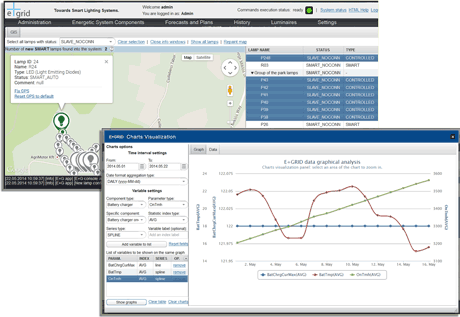by Balázs Csanád Csáji, Borbála Háy, András Kovács, Gianfranco Pedone, Tibor Révész, and József Váncza
The concepts of smart cities and self-sustaining renewable energy systems are revolutionizing the world of public lighting. This paper presents the architecture of a novel, adaptive and energy-positive outdoor lighting system, as well as the IT solutions that control and monitor the operation of the whole system.
This research was motivated by the potential opportunities to use renewable, solar energy in public lighting services via the appropriate combination of LED luminaries, energy generation and storage, as well as sensor technologies with novel data processing, communication and control methods. To this end, an industry-academy consortium formed by GE Hungary, the Budapest University of Technology and Economics, and two institutes of the Hungarian Academy of Sciences (MFA and SZTAKI) developed a so-called energy-positive community microgrid (E+grid). E+grid balances energy demand against production and guarantees the required level of street lighting even at times of moderate-duration power outages. In this article, we outline the key aspects of the information, communication and control features of the E+grid system.
System architecture
The E+grid system reduces the energy consumption of street lighting by using LED luminaries that regulate their lighting levels according to the surrounding environmental conditions, thus providing just the required level of lighting at all times. This is achieved by mounting motion sensors and smart controllers to each light pole, which are then connected by wireless communication. A positive yearly energy balance is achieved by photovoltaic (PV) energy generation, whereas protection against power outages is guaranteed by battery storage. The system has a bi-directional grid connection, which enables trading with electricity and can be used to exploit variable energy tariffs. Energy flows are monitored by smart meters. A local weather station collects weather data and hosts a twilight switch which allows for the lighting periods to respond to the current environmental conditions. The overall system (Figure 1) is monitored and controlled by a central computer (CC): black connectors indicate power flow while red lines show information flow (smart meters are not depicted).

The central computer
The CC of E+grid, an innovative cloud-deployed software application, is one of the key orchestrators of the system, enabling the adaptive lighting behaviour. Its core functions include:
- which are delivered by a web application and the extensive use of JavaScript. The graphical user interface (GUI) (Figure 2) provides friendly access to, among others, the geographic information system (GIS) of the installed luminaries, the management of the energetic components and the visual analysis and export of the collected data; and
- which enable the outer platform components to communicate with the CC. These are provided through a dedicated layer which is responsible both for handling the connections and validating the semantics. Each component is assisted by a proper data synchronization process, whereas the control of the outdoor lighting system is delegated to a specific lighting scheduler.

Controlling the energy flow
One of the main roles of the CC is controlling the energy flow, not only for minimizing the total energy cost, but also for ensuring the robustness against power outages through the use of battery storage. To achieve this, energy production and consumption must be forecasted. This is carried out by fitting time series models to the available data [1]. An assessment of several different models showed that good predictions of energy production can be obtained using nonlinear autoregressive exogenous (NARX) models. These models use wavelet-type nonlinearities, where the exogenous components come from a clear-sky model. Efficient energy consumption forecasts can also be achieved using Box-Jenkins type models, where the exogenous inputs come from averaged historical data. The controller itself uses a model-predictive approach and works on a rolling-horizon where each time step involves solving a linear optimization problem [1].
Prototype system
The E+grid system design has been validated through simulation experiments which confirmed that the system can achieve a slightly positive yearly energy balance. A physical prototype, containing 130 luminaries and 152 m2 of PV panels is currently being deployed at the campus of the MFA Institute of the Hungarian Academy of Sciences. This prototype adopts three different battery technologies and four types of PV panels in order to evaluate their long-term performance under real-life environmental conditions.
Acknowledgement
This project has been supported by grants from the National Development Agency, Hungary, under contract numbers KTIA KMR 12-1-2012-0031 and NFÜ ED-13-2-2013-0002. B. Cs. Csáji acknowledges the support of the János Bolyai Research Fellowship No. BO/00683/12/6.
Reference:
[1] B. Cs. Csáji, A. Kovács, J. Váncza: “Prediction and robust control of energy flow in renewable energy systems”, in proc. of the 19th IFAC World Congress, to appear, 2014.
Please contact:
András Kovács
Fraunhofer PMI, SZTAKI, Hungarian Academy of Sciences, Hungary
Tel: + 36 1 279 6299
E-mail:










